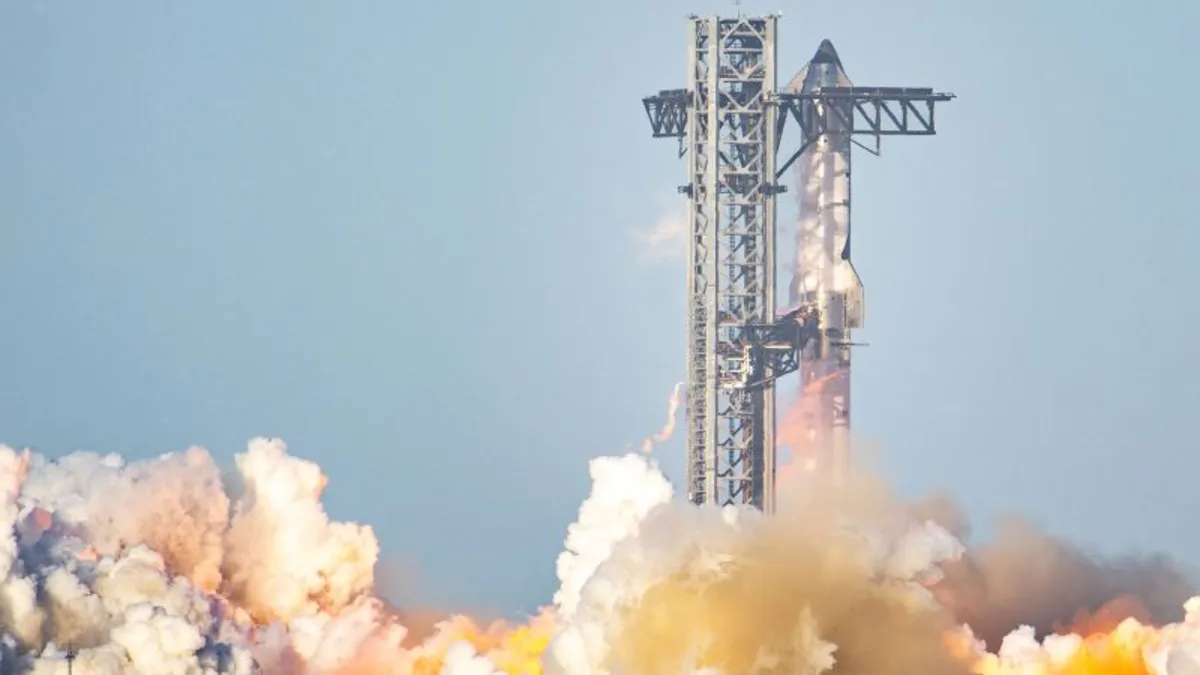
On Thursday night, SpaceX launched its eighth integrated test flight of the colossal Starship megarocket system, aiming to enhance its capabilities and address shortcomings from previous missions. This uncrewed flight lifted off from SpaceX’s Starbase facility in South Texas at 5:30 p.m. CT (6:30 p.m. ET), following a scrub of a planned launch earlier in the week due to “too many question marks,” as noted by SpaceX CEO Elon Musk.
The Starship spacecraft, which serves as the upper stage of the rocket, was mounted atop the impressive 232-foot-tall (71-meter-tall) Super Heavy booster. Approximately 2.5 minutes into the flight, the Super Heavy successfully separated from the upper stage, marking a significant milestone in the mission. The booster then executed a successful landing within the “chopstick” arms of SpaceX’s launch tower, known as “Mechazilla,” near Brownsville, Texas. This marked the third successful capture of a Super Heavy booster by SpaceX’s innovative chopstick system.
Following separation, the Starship spacecraft ignited its engines, aiming for a suborbital trajectory that was expected to last about an hour. Unfortunately, just 20 seconds before completing its ascent burn, contact with the spacecraft was lost. Dan Huot from SpaceX explained that the loss of several center engines led to a loss of attitude control, causing the spacecraft to spin uncontrollably.
Approximately 17.5 minutes after launch, Starship was set to deploy a batch of mock Starlink satellites for the first time. However, similar to its predecessor Flight 7, which ended in an explosion over populated islands in Turks and Caicos, communication was lost at a critical moment during this flight. The explosion was reportedly visible from parts of Florida and occurred over the Caribbean, prompting the Federal Aviation Administration (FAA) to halt flights into several major airports due to “falling space debris.”
In the aftermath of the explosion, SpaceX promptly coordinated with safety officials to implement pre-planned contingency responses. The company updated the public via X (formerly Twitter), stating, “During Starship’s ascent burn, the vehicle experienced a rapid unscheduled disassembly and contact was lost.” They emphasized their commitment to reviewing data from the flight test to understand the root cause of the malfunction.
The FAA has mandated a mishap investigation into the loss of the Starship vehicle. This investigation aims to enhance public safety, identify the root cause of the incident, and recommend corrective actions to prevent future occurrences. The FAA will oversee the investigation process and must approve SpaceX’s final report and any corrective actions before the company can return to flight.
Thursday's flight test was designed to rigorously assess the Starship spacecraft and identify potential weak points. Engineers modified the spacecraft significantly, removing a large number of heat shield tiles to expose vulnerable areas. These tiles are crucial for protecting the spacecraft from extreme temperatures exceeding 2,600 degrees Fahrenheit (1,427 degrees Celsius) during reentry. New materials, including a metallic tile with active cooling properties, were also tested.
SpaceX made several upgrades following the failed Flight 7, which ended in a fiery mishap on January 16, resulting in debris raining down on the islands of Turks and Caicos. These enhancements included new vent systems, a purge system to prevent fire, and modifications to fuel lines and engine thrust targets. The Starship design was also adjusted to stand 6.5 feet (2 meters) taller, increasing its propellant volume by about 25%, which may allow for longer missions in the future.
Despite the setbacks, SpaceX remains committed to advancing its Starship program. The company is expanding its operations to Florida, building a new facility named Gigabay adjacent to its current HangarX location at NASA’s Kennedy Space Center. This expansion is intended to increase the production and flight capabilities of Starship vehicles.
The eighth test flight serves as another chapter in SpaceX's quest to refine its technology and achieve reliable space travel. While the loss of the Starship vehicle is a setback, the lessons learned from this flight will be invaluable as the company continues to innovate and push the boundaries of space exploration.